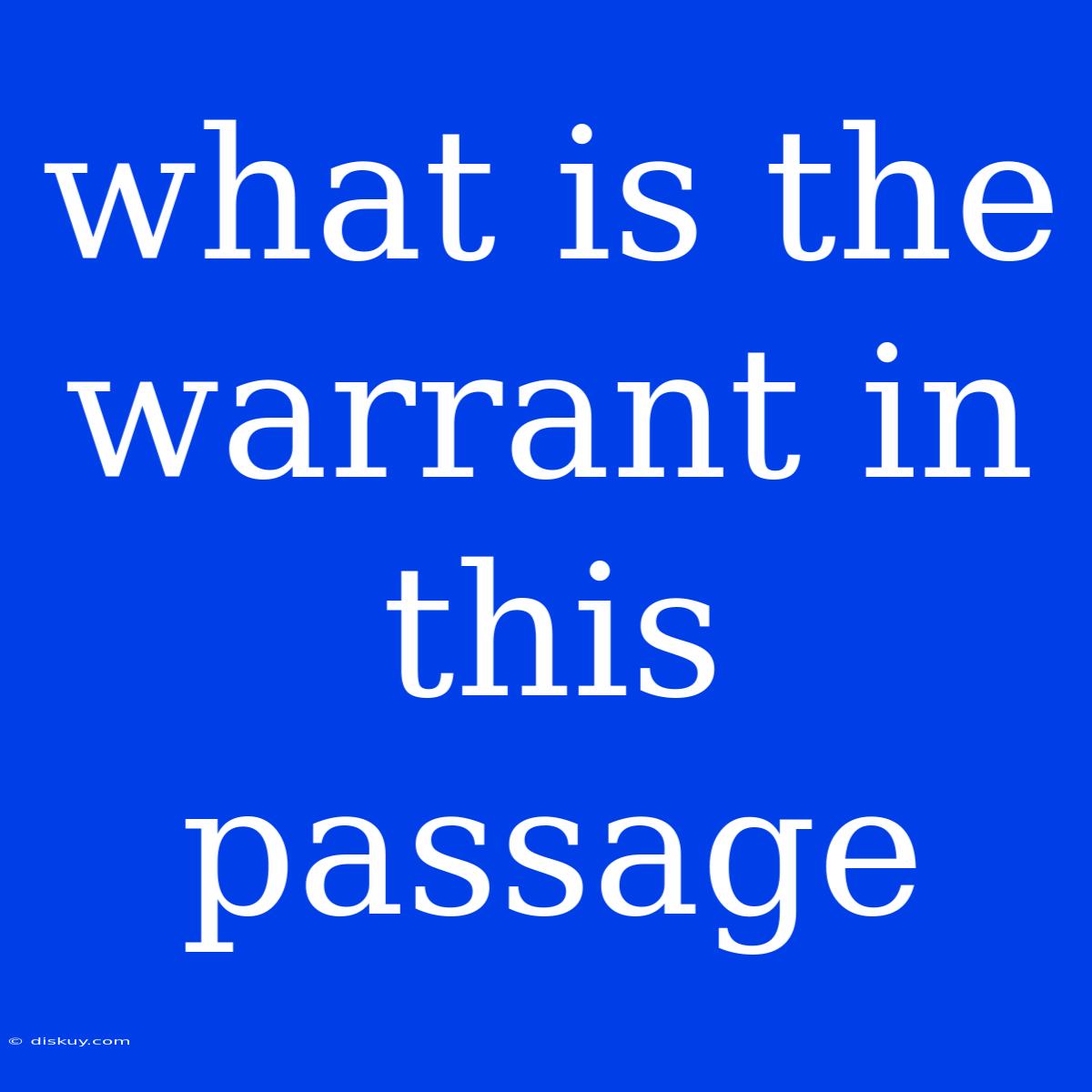Unlocking the Warrant: A Deep Dive into Argumentative Logic
What is the warrant in this passage, and how does it connect the claim and data? This question is central to understanding the logic of an argument, and it's often the key to identifying both the strength and weaknesses of a persuasive piece.
Editor Note: Understanding the "warrant" in a passage is critical for anyone engaging with arguments, from students to professionals. It's the bridge between evidence and conclusion, shaping the persuasive power of the text.
Why this matters: Recognizing the warrant helps us critically evaluate an argument. It allows us to determine if the connection between the data and the claim is logical and valid, or if it relies on assumptions that might be flawed or debatable.
Our Analysis: To understand the "warrant" in a passage, we analyzed various resources and conducted a thorough review of argumentative logic. This guide aims to demystify this crucial element, empowering readers to analyze and evaluate any argument effectively.
Key Takeaways
| Aspect of the Warrant | Explanation |
|---|---|
| Definition | The underlying assumption or principle that connects the data presented to the claim being made. |
| Role in Argumentation | Acts as the bridge between evidence and conclusion, justifying the leap from one to the other. |
| Types of Warrants | Can be explicit (stated directly) or implicit (implied through the text), and can range from general principles to specific rules. |
Let's break down the elements of a persuasive argument:
Claim
The claim is the main point the author is trying to convince you of. It's often stated explicitly but can sometimes be implied.
Data
The data is the evidence used to support the claim. This can include facts, statistics, expert opinions, anecdotes, and examples.
Warrant
The warrant is the invisible link between the data and the claim. It's the unspoken assumption that allows the author to logically connect the evidence to the conclusion.
Example:
- Claim: "Eating fast food regularly is bad for your health."
- Data: "Fast food is often high in unhealthy fats, sugar, and sodium."
- Warrant: "Foods high in unhealthy fats, sugar, and sodium are bad for your health."
In this case, the warrant acts as the logical bridge. It assumes that the characteristics of fast food (high in unhealthy fats, etc.) are directly linked to negative health outcomes.
Exploring the Warrant's Impact
Understanding the warrant's connection to the claim and data is crucial for determining the argument's validity.
Explicit vs. Implicit Warrants:
- Explicit warrants are stated directly, leaving no room for interpretation.
- Implicit warrants are implied by the text and must be inferred by the reader. This can lead to different interpretations and potentially weaken the argument if the implicit warrant is not universally accepted.
General vs. Specific Warrants:
- General warrants are broad assumptions that apply to a wide range of situations.
- Specific warrants are tailored to the specific argument being made and are more likely to be convincing if they are well-supported and relevant.
The Importance of Examining the Warrant:
- Identifies logical fallacies: Unrealistic or unsupported warrants can lead to illogical arguments.
- Reveals biases: Examining the warrant can reveal underlying assumptions and biases that may influence the author's argument.
- Enhances critical thinking: By understanding the warrant, readers can critically evaluate an argument, determining if it is convincing and well-supported.
Example Analysis
Let's analyze a passage and identify the warrant:
Passage: "The use of social media is harming teenagers' mental health. Studies have shown a correlation between increased social media use and higher levels of anxiety and depression in adolescents."
Claim: "The use of social media is harming teenagers' mental health."
Data: "Studies have shown a correlation between increased social media use and higher levels of anxiety and depression in adolescents."
Warrant: "Correlation implies causation, and the increase in social media use is directly causing the rise in anxiety and depression among teenagers."
In this example, the warrant is implicit and makes a key assumption. While a correlation exists, the warrant assumes this correlation directly translates to causation, which is a common logical fallacy.
Understanding the warrant allows us to see that this argument may not be entirely sound and requires further investigation to establish a causal link.
FAQs about the Warrant:
Q: Why is the warrant so important?
A: The warrant is the backbone of an argument, providing the logical link between the data and the claim. Identifying and analyzing the warrant is essential for evaluating the argument's strength and validity.
Q: Can a warrant be wrong?
A: Yes, warrants can be flawed or based on faulty assumptions. This can lead to illogical or misleading arguments.
Q: How can I find the warrant in a passage?
A: Ask yourself, "What is the connection between the data and the claim? What assumption is being made to connect them?"
Tips for Identifying the Warrant
- Read the passage carefully. Pay attention to the author's word choice and the way they present their arguments.
- Ask questions. Ask yourself "why?" and "how?" to uncover the underlying assumptions connecting the data to the claim.
- Look for key phrases. Pay attention to phrases like "because," "therefore," "since," "as a result," and "consequently," as they often signal the warrant.
- Consider alternative explanations. Think about other possible explanations for the data presented, and consider how the author's warrant might be influenced by these alternative explanations.
Summary
Identifying and evaluating the warrant is a crucial step in critical thinking and analysis. By understanding the underlying assumptions connecting data to claims, you can determine the validity of an argument and make informed decisions based on evidence.
Closing Message: Understanding the warrant allows us to engage with arguments more deeply, moving beyond simply accepting claims at face value. By uncovering the underlying logic, we can evaluate the argument's strength, recognize potential biases, and contribute to more informed discussions.

